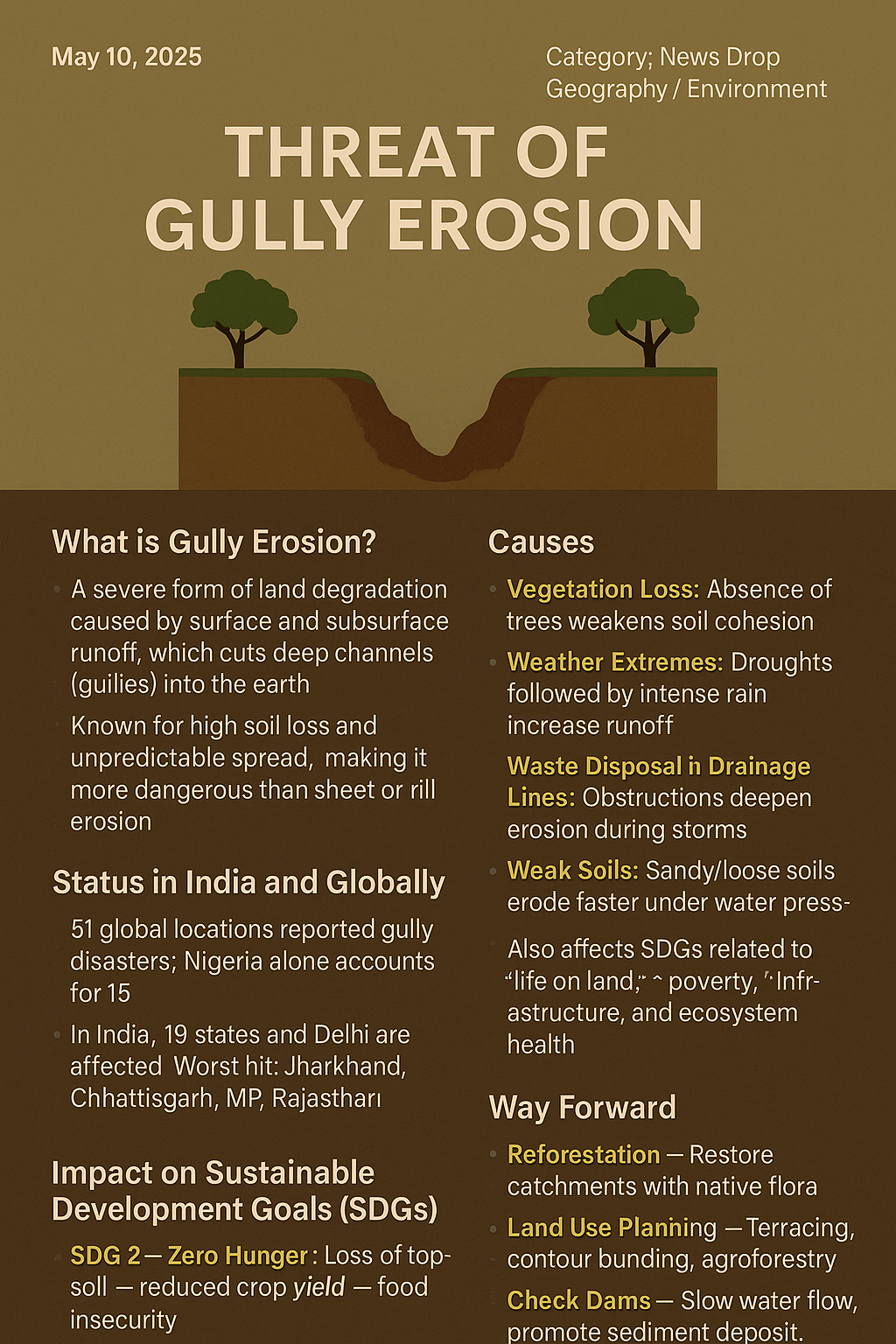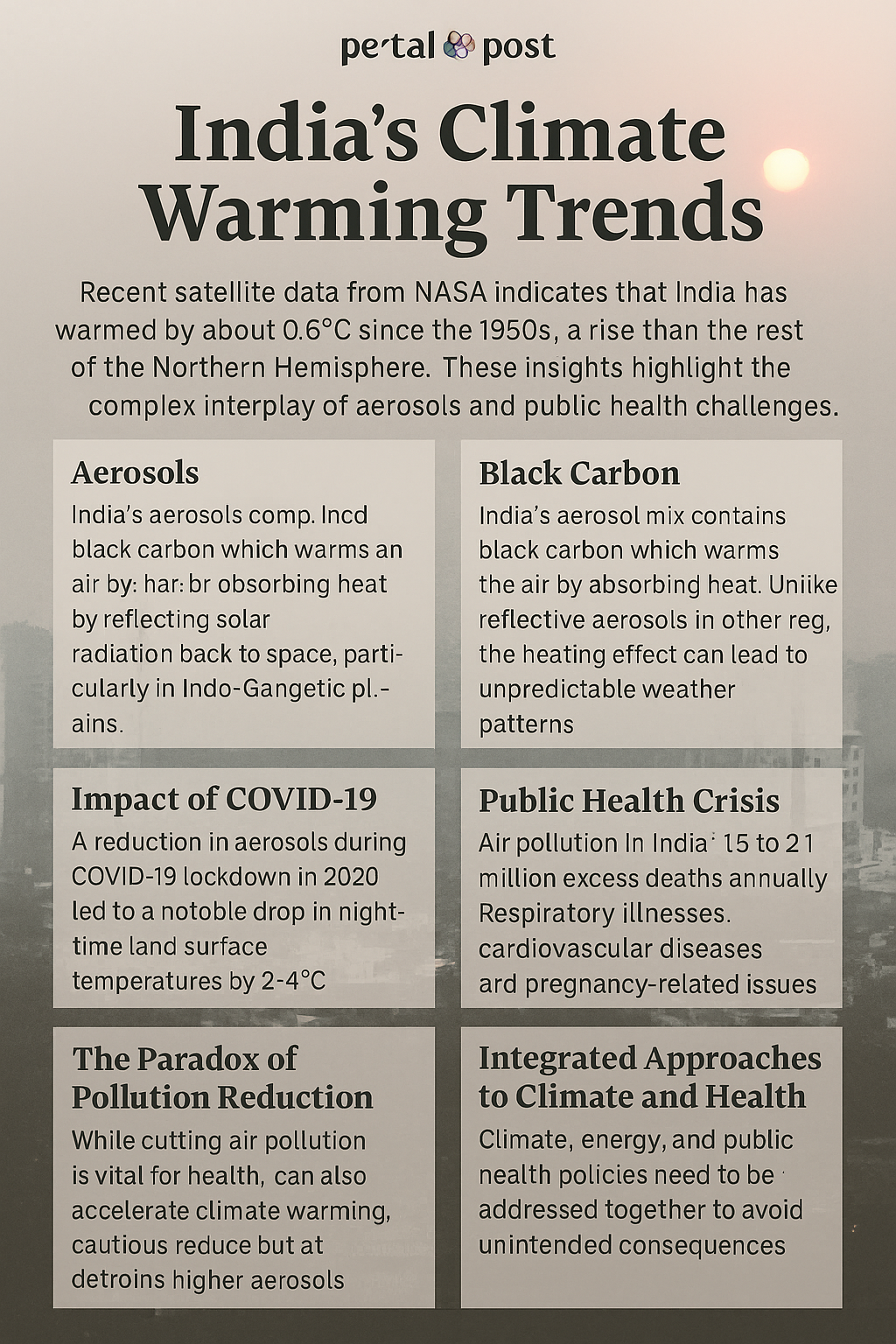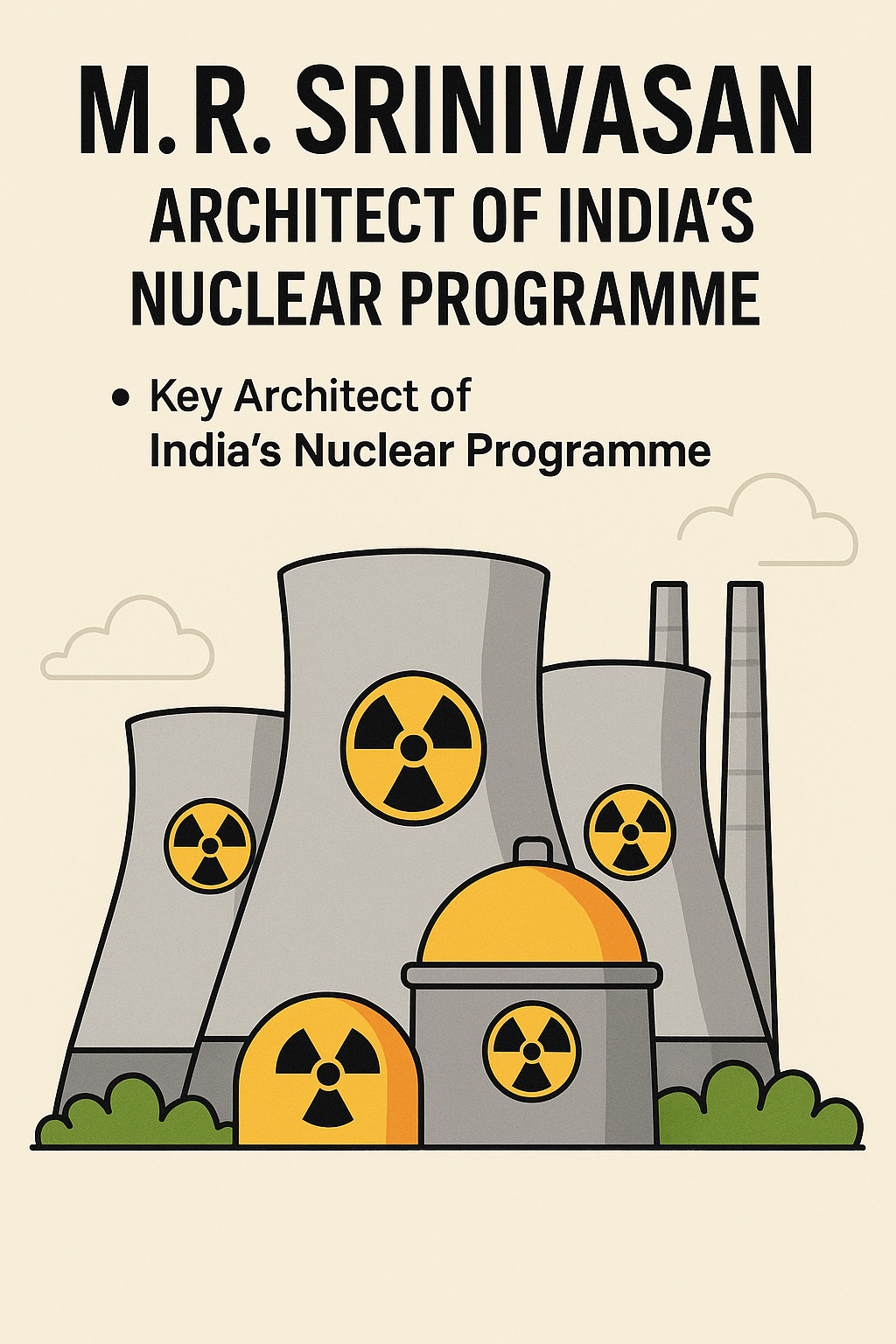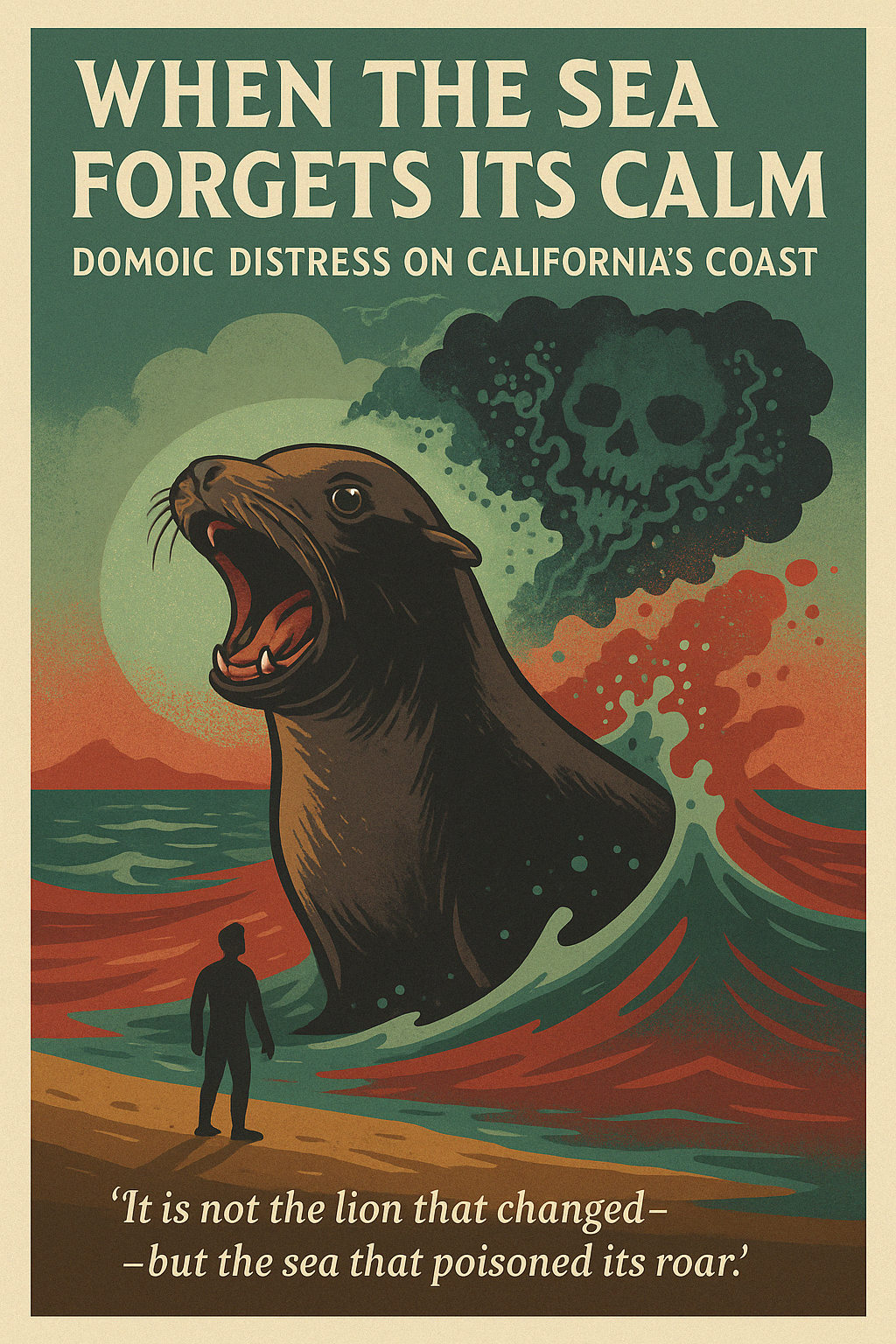
📅 May 10, 2025, Post 1: 🌍 GULLY EROSION: THE SILENT SCOURGE | Mains Essay / Target IAS-26 MCQs Attached: A complete Package, Dear Aspirants!
🌍 GULLY EROSION: THE SILENT SCOURGE

May 10, 2025 |— PETAL 001 | Category: News Drop / Geography / Environment
🌿 Intro Whisper:
When the land begins to bleed in silence, it’s not war—it’s erosion. And its deepest wounds are gully-shaped.
📜 Key Highlights
What is Gully Erosion?
• A severe form of land degradation caused by surface and subsurface runoff, which cuts deep channels (gullies) into the earth.
• Known for high soil loss and unpredictable spread, making it more dangerous than sheet or rill erosion.
Status in India and Globally
• 51 global locations reported gully disasters; Nigeria alone accounts for 15.
• In India, 19 states and Delhi are affected. Worst hit: Jharkhand, Chhattisgarh, MP, Rajasthan.
Causes
• Vegetation Loss: Absence of trees weakens soil cohesion.
• Weather Extremes: Droughts followed by intense rain increase runoff.
• Waste Disposal in Drainage Lines: Obstructions deepen erosion during storms.
• Weak Soils: Sandy/loose soils erode faster under water pressure.
Impact on Sustainable Development Goals (SDGs)
• SDG 2 – Zero Hunger: Loss of topsoil → reduced crop yield → food insecurity
• SDG 6 – Clean Water: Disrupted recharge → droughts & water stress
• SDG 13 – Climate Action: Accelerated land degradation exacerbates climate vulnerability
• Also affects SDGs on life on land, poverty, infrastructure, and ecosystem health
🧭 GS Mapping
GS Paper 1 – Geography (Soil, Land Degradation)
GS Paper 3 – Environment, Conservation, Climate Change, SDGs
Essay – Land and its Silent Crisis
🛠️ Way Forward
• Reforestation – Restore catchments with native flora
• Land Use Planning – Terracing, contour bunding, agroforestry
• Check Dams – Slow water flow, promote sediment deposit, and stabilise gully beds
💭 A Thought Spark — by IAS Monk
A gully is not a crack in the land—it is a fracture in our care. To heal it is not just to plant trees, but to restore the forgotten relationship between land and life.
High Quality Mains Essay For Practice :
Word Limit 1000-1200
Land and Its Silent Crisis
In the fast-paced story of modern development, land—the very ground beneath our feet—remains voiceless. It does not march in protest or erupt in rebellion, but it suffers. Its agony is not heard in newsrooms but felt by farmers, forests, rivers, and future generations. The crisis of land degradation is not dramatic, but it is devastating. And that is what makes it a silent crisis—one that unfolds without alarms, yet undermines the very foundations of life, livelihood, and sustainability.
Introduction: Land – The Canvas of Civilization
Land is more than a physical resource. It is the canvas on which the human story is written. From agriculture to architecture, from identity to economy, land is at the heart of human existence. Yet, in our relentless pursuit of growth, we have turned this sacred ground into a casualty. Urban sprawl, mining, deforestation, and unscientific agriculture have silently chipped away at the vitality of land.
Today, over 25% of Earth’s land is degraded, impacting over 3.2 billion people. India alone has over 96 million hectares under degradation, posing threats not just to food and water security, but to the country’s social fabric.
Understanding the Silent Nature of the Crisis
Unlike climate change or air pollution, land degradation doesn’t attract immediate attention. Why?
- It is gradual – Gully erosion, salinisation, and desertification happen slowly, often over years or decades.
- It is hidden – Much of the damage is underground or remote—loss of soil fertility, depletion of groundwater, and biodiversity erosion.
- It lacks spectacle – No dramatic visuals like floods or wildfires accompany land degradation.
- It is normalized – Barren fields, dry wells, and infertile soil are often accepted as natural, not seen as systemic failures.
This quiet unraveling makes the land crisis especially dangerous—it creeps under the radar while weakening the base of sustainability.
The Many Faces of Land Degradation in India
- Soil Erosion:
– Water-induced erosion (sheet, rill, gully) in states like MP, Jharkhand, and Chhattisgarh
– Wind erosion in Rajasthan and Gujarat
– Over 29% of India’s total geographical area is affected - Desertification:
– Expanding in semi-arid zones, reducing arable land
– Rajasthan, Gujarat, Maharashtra most vulnerable - Salinisation and Waterlogging:
– Poor irrigation practices lead to salt accumulation and reduced productivity
– Punjab and Haryana show alarming signs - Urbanization and Land Sealing:
– Cities eat into fertile land and forests
– Paved surfaces reduce groundwater recharge and increase surface runoff - Mining and Industrial Pollution:
– Open cast mining and toxic effluents degrade land and pollute water tables
Impact: Why This Crisis Matters
1. Food Insecurity
Loss of topsoil reduces yields and makes farming more input-dependent.
India’s aim of achieving zero hunger (SDG 2) becomes harder as land productivity falls.
2. Water Scarcity
Degraded land loses its ability to retain water, leading to droughts, drying wells, and failed crops.
3. Climate Change Acceleration
Land degradation leads to carbon release, and reduces the land’s capacity to act as a carbon sink.
It also increases vulnerability to floods and storms.
4. Biodiversity Loss
Habitat fragmentation from land misuse pushes wildlife to the brink and breaks ecosystem chains.
5. Rural Distress and Migration
Unproductive land → failing farms → debt → rural exodus → slums in cities → social strain
Land degradation is often the first link in the chain of agrarian distress.
Global and National Responses
🌍 At the Global Level:
• UNCCD (UN Convention to Combat Desertification) – India is a signatory, with a pledge to restore 26 million hectares by 2030
• Bonn Challenge – Global effort to restore 350 million hectares by 2030
• Sustainable Development Goals (SDG 15) – Life on land
🇮🇳 At the National Level:
• National Action Plan to Combat Desertification
• Soil Health Card Scheme
• PM-KUSUM – Promoting solar pumps to reduce groundwater overuse
• Watershed Management Projects
• Afforestation programs under CAMPA and Green India Mission
Yet, implementation remains uneven, funding inconsistent, and community involvement limited.
The Way Forward: Healing the Land, Silently but Surely
1. Sustainable Agriculture
– Promote organic farming, agroforestry, and natural farming
– Reduce chemical input and improve soil organic matter
2. Water-Soil Harmony
– Contour bunding, check dams, and rainwater harvesting to reduce runoff and erosion
– Revive traditional water systems like tanks, stepwells, and johads
3. Reclaim and Restore
– Use wasteland development for afforestation and pasture revival
– Plant native species for long-term ecosystem healing
4. Decentralized Governance
– Empower panchayats and forest user groups
– Make land stewardship a community-led process
5. Urban Planning and Land Zoning
– Stop reckless construction and enforce green zones
– Integrate climate-resilient land use policies
6. Public Awareness and Education
– Land literacy in schools, campaigns, and media
– Citizens must understand that land is not an infinite resource
Conclusion: The Whisper Beneath Our Feet
The land will not scream. It will simply stop producing. Stop recharging. Stop nurturing. And by the time we notice, it may be too late. The silent crisis of land degradation is not a future problem—it is a present emergency. Yet, it carries within it the possibility of healing. For land has always responded well to care—gentle, sustained, and humble.
In our race to the stars, let us not forget the soil. For when the land suffers, everything that stands on it trembles. The real revolution of the 21st century must be a silent one—the revolution of land stewardship.
Target IAS-26: Daily MCQs :
📌 Prelims Practice MCQs
Topic:
MCQ 1 (Type 1)
Consider the following statements regarding land degradation in India:
1. More than one-fourth of India’s total geographical area is affected by land degradation.
2. Water-induced erosion is the most common form of land degradation in India.
3. Salinisation is primarily caused by unscientific irrigation practices.
4. Wind erosion is most prevalent in eastern India.
How many of the above statements are correct?
A) Only two
B) Only three
C) All four
D) Only one
🌀 Didn’t get it? Click here (▸) for the Correct Answer & Explanation
✅ Correct Answer: B) Only three
🧠 Explanation:
1) Correct – Around 29% of India’s land is degraded. • 2) Correct – Water-induced erosion (rill, gully, sheet) is most common. • 3) Correct – Improper irrigation leads to salinisation and waterlogging. • 4) Incorrect – Wind erosion is common in western India (Rajasthan, Gujarat). ✅ Thus, statements 1, 2, and 3 are correct.
MCQ 2 (Type 2)
Statement 1: Land degradation contributes to climate change by releasing carbon stored in soil.
Statement 2: Land degradation has no significant impact on Sustainable Development Goals.
Which of the above statements is/are correct?
A) Only 1 is correct
B) Only 2 is correct
C) Both are correct
D) Neither is correct
🌀 Didn’t get it? Click here (▸) for the Correct Answer & Explanation
✅ Correct Answer: A) Only 1 is correct
🧠 Explanation:
1) Correct – Land degradation releases carbon, reducing the soil’s role as a carbon sink.
• 2) Incorrect – It significantly affects SDG 2 (Zero Hunger), SDG 6 (Clean Water), and SDG 15 (Life on Land), among others. ✅ Only Statement 1 is correct.
MCQ 3 (Type 3)
Which of the following are part of India’s efforts to address land degradation?
1. Soil Health Card Scheme
2. Green India Mission
3. PM-KUSUM
4. National River Linking Programme
Select the correct answer using the code below:
A) 1, 2 and 3 only
B) 2, 3 and 4 only
C) 1 and 4 only
D) All four
🌀 Didn’t get it? Click here (▸) for the Correct Answer & Explanation
✅ Correct Answer: A) 1, 2 and 3 only
🧠 Explanation:
•1) Yes – Promotes soil fertility awareness among farmers.
• 2) Yes – Aims to improve forest cover and restore degraded land.
• 3) Yes – Encourages solar pumps, reducing groundwater overuse.
• 4) No – The river linking programme is not directly aimed at land restoration and is controversial regarding ecological impact. ✅ Thus, only 1, 2, and 3 are correct.
MCQ 4 (Type 4 – Direct Factual)
Which international convention is dedicated to combating land degradation and desertification?
A) UNFCCC
B) UNCCD
C) UNCBD
D) FAO Treaty on Land Reform
🌀 Didn’t get it? Click here (▸) for the Correct Answer & Explanation.
✅ Correct Answer: B) UNCCD
🧠 Explanation:
The United Nations Convention to Combat Desertification (UNCCD) focuses on land degradation, drought, and desertification. ✅ India is a signatory and has pledged to restore 26 million hectares by 2030.


















